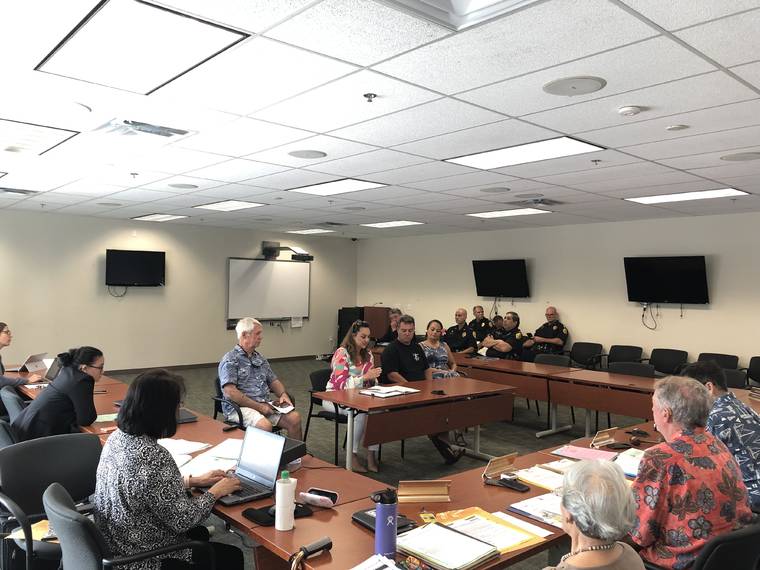Paddlers say homeless ruining bays

KAILUA-KONA Graffiti, drug use, defecation and other illegal activities have reached a point where the Big Islands paddling community is pushing back.
KAILUA-KONA — Graffiti, drug use, defecation and other illegal activities have reached a point where the Big Island’s paddling community is pushing back.
“It’s intimidating for the kids,” said Doug Bumatay, Moku O Hawaii Outrigger Canoe Racing Association vice president and Paddlers of Laka athletic director. “Right now, it’s the middle of the high school season and they don’t even want to go to the bathrooms. They don’t want go use the restrooms. They don’t want to go in there to change. It’s terrible.”
While Bumatay was describing the unsavory conditions presented at Hilo Bayfront, the situation is the same around the island, according to the association that comprises 15 canoe clubs.
“When the (Kailua Pier) bathrooms are closed, the homeless are starting to use our canoes as their faculties,” said Kai Opua Athletic Director Mike Atwood, who is also a board member of the association. “It creates a health issue as well as a potential safety issue once the paddlers come down the next day.”
And it’s been escalating.
“In the last several months, this activity has increased dramatically down at Bayfront,” said Bumatay. “It’s always been there, but kind of in the shadows, but now it’s right up front.”
About a dozen people from the association’s member clubs brought forth the issue before the Hawaii County Police Commission during its monthly meeting Friday at the West Hawaii Civic Center.
Joining them was Hilo Councilwoman Sue Lee Loy, who is helping to spearhead the effort with the hope of finding a solution now and for the long run as the Big Island will soon be in the spotlight for the 2020 IVF World Sprints in Hilo Aug. 15-23 followed by the annual Queen Liliuokalani Canoe Race in Aug. 29-Sept. 2.
“We’ve got to learn to work smarter, not harder,” said Lee Loy. “So, I dove into the (County) Charter and looked at the charge of what the police department could do but more importantly this body (the police commission) can do, and there’s a section in the Charter and also in your rules that allows this body to kind of direct the police chief on police-community relations.”
She said the commission was the perfect “springboard” to start the effort as community concerns can be brought there, backed up with data and then routed to the County Council.
“Chair (Aaron) Chung and myself stand ready to help this community, but more importantly to improve experiences, not only for the canoe clubs, but at all of our beach parks,” Lee Loy said. “We have tools in our tool belt where we can actually push policy, legislative pieces. We also control the budget for not only parks but this (the police) department as well. If they could begin to share with you what their concerns are, what actions they are looking for, and how we can better dovetail all of that work together, I think you will be working smarter not harder.”
Police Commission Chairman John Bertsch recognized the extent of the problem, noting that in his 13 years on the commission, he’s never had people from around the whole island discussing a single issue before it. He said what is occurring is a criminological theory called the “broken windows theory.”
“Basically crime proliferates crime,” he said. “Once you start to see (crime) then it starts to snowball and exacerbate itself and we need to get our hands wrapped around it.”
But, it’s not just a police issue.
“This is a community effort that is going to require the concerted efforts of the council, the commission, the department and the canoe clubs all working in concert to remedy this problem,” he said after pledging the commission’s help. “Maybe the solution is to set up new drug-free zones in these activity areas just like we do in the schools or curfew for areas. I don’t know what the solution is, but I welcome the conversation, and I think that any one of the commission members would be happy to sit on a steering committee.”
After the meeting, Hawaii Police Department Chief Paul Ferreira said the concerns are on the department’s radar.
“It is a priority,” he said.
Other police news:
Ferreira said the department is proceeding with its body-worn camera program. Field tests will be conducted in February and March for models provided by two vendors.
As of Dec. 31, 2019, the department had 82 unfilled sworn positions with 18 of those positions to be filled by recruit officers currently undergoing training in the 91st recruit class, according to information presented by HPD Administrative Bureau Assistant Chief Samuel Thomas. Including the 18 recruits, the department has 86.7% of sworn positions filled.
The 92nd recruit class is set to begin Feb. 18, though the department is not sure yet how many recruits will be hired as the process of background checks, polygraphs and psychological exams hasn’t yet wrapped up.
An agility test for the 93rd recruit class is set for Jan. 31 with recruit class tentative set to start in June.
During the first six months of fiscal 2019-20, Thomas said, the department had targeted spending 52.76% of its $70 million budget but had expended 53.98%. He cautioned that the figure includes encumbrances for contracts paid in full for the entire year.
Salary and wages budget is also over the 54.17% projected to have been spent during the first six months of the fiscal year with 59.18% of the funds budgeted spent.
“A lot of it is attributed to the TMT (Thirty Meter Telescope) overtime and we are still waiting an agreement between the state and the county for repayment,” said Thomas.


